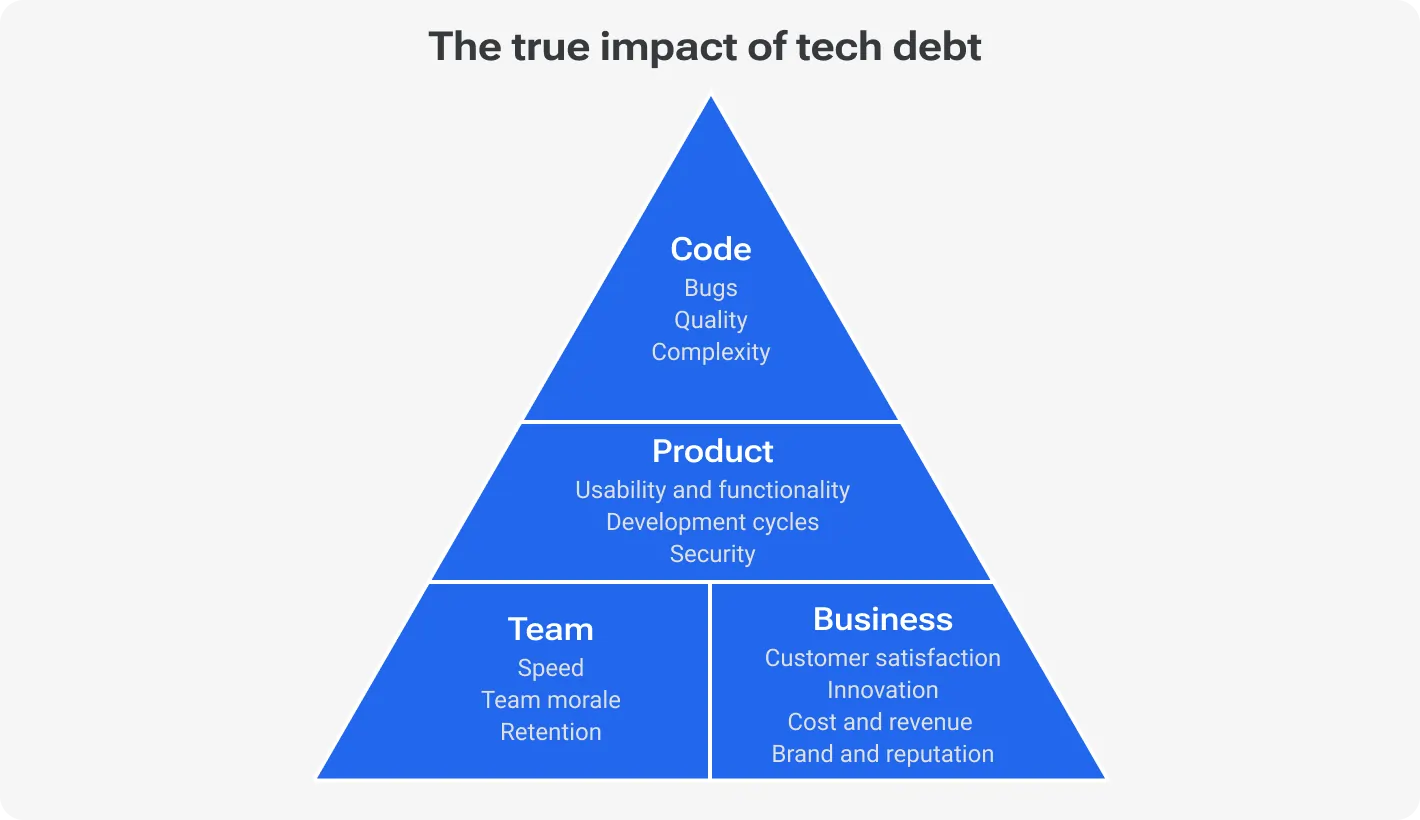Not properly managed technical debt “devours” the company’s time and money. Developers are forced to waste up to 42% of their working hours due to it. And the organizations spend on average 10-20% of their budget on new projects to solve the issues related to this phenomenon.
How to avoid extra time and money expenses? Create and execute a clear and consistent technical debt action plan. How to do it? Learn from this article! Below, you will find step-by-step instructions and practical tips for this.
Tech debt influence on business
This is a twofold phenomenon. In the short term, it can have a positive impact. By choosing the fastest solutions instead of the best-quality ones, it is possible to significantly reduce the time to market and overtake competitors.
But if this debt is not “paid off”, it can provoke “interest” and other complications, like a real money loan. If the company doesn’t do anything to manage this phenomenon, in the long run, it is likely to face numerous problems, including:
Wasting time. Due to the shortcomings in the fulfillment of the previous tasks, the completion of the subsequent ones becomes more difficult and time-consuming. Engineers have to spend their working hours struggling to understand the unclear code sections, making edits to poor-quality parts, and so on. On average, solving tech debt issues takes 23% of developers’ work time, but in severe cases, this figure may reach up to 43%. This provokes a drop in productivity. Thus, by sacrificing quality for speed once, the team loses its speed in the future.
Additional financial expenditures. For a business, time equals money. A company spends its budget to pay for developers' time, which they spend on solving tech debt problems. Other costs may also increase due to this phenomenon. For example, slower recovery from force majeure, as well as the search and adaptation of new employees. In neglected cases, some organizations lose up to 50% of their IT budget because of tech debt.
Decrease in flexibility. Due to the drop in productivity, there may be delays in updates, changes, and enhancements of the products. Also, sometimes due to technical debt, the team is forced to use less flexible technologies. This can lead to problems with amendments and improvements in the future.
Difficulties in further business development. This point is closely related to the previous one. Due to reduced agility, companies not only lose the ability to make quick edits and updates but also experience difficulties in the digital transformation of their workflows.
Staff problems. Shortcomings in the quality of code, documentation, or other aspects of the product can provoke misunderstandings, conflicts between coworkers, and increased fatigue and burnout among engineers who fix these flows. All of this can increase turnover, as well as make it harder for new team members to adapt. As a result, both time and money HR-related expenditures increase.
Larger force majeure losses. In the case of crashes and failures, the business loses revenue for every minute of downtime. Tech debt can lead to longer recovery times as the reduced flexibility and productivity contribute to this.
A step-by-step guide to creating a technical debt action plan
Managing this phenomenon properly can help avoid extra costs, boost productivity, accelerate workflow, and gain more opportunities for future growth. What is the right way to deal with it? Here are 5 steps to succeed.
Step 1: Identify and evaluate technical debt issues
To cope with the problems effectively, it is important to identify them in the early stages. So, first, you need to determine whether your company has tech debt and what its amount is.
Metrics for measuring tech debt
To determine whether you have tech debt and what its scale is, use the following metrics:
Defect ratio: the size of the software (can be measured in modules, lines of codes, etc.) divided by the number of defects.
The average time it takes to fix a bug.
Lead time: the duration of the process of adding a new feature.
Time to market: duration of all work on a new project from conception to release.
Code duplication rate: the percentage of duplicates in the whole code scope.
Code churn rate: the metric that represents the amount of code that was edited or rewritten.
Technical debt ratio (tech debt fixing expenditures divided by the whole development cost and multiplied by 100%).
Identifying exact flaws
To determine what exactly triggers tech debt, it is also necessary to perform a code review. It will help evaluate if the code is quality and readable. Check whether:
there are bugs, if they are, how many, and whether they are easy to fix;
the code contains comments that make it more readable;
it is easy to understand for an engineer who is seeing it for the first time, if not, why, and how this can be changed;
a sufficiently flexible set of technologies was chosen during development;
it is easy to make changes and updates to the code when needed.
When defects are identified, they should be documented and categorized for ease of creating a further strategy to address them.
Empower your IT team to focus on innovation and growth by outsourcing your technical debt management
Prioritization
To create a powerful strategy to deal with this phenomenon, determine which issues are crucial and need urgent fixing and which are not significantly affecting your workflow and business. The quadrant technique can help you prioritize the issues correctly. Place each flaw into one of four groups:
Critical: the issues that make stumbling blocks for further business growth and need urgent fixing.
Important: the flaws that significantly influence the workflow and lead to additional costs and other problems.
Low priority: the defects that do not have a critical impact on business but which are still desirable to correct if you strive for perfection.
Negligible: the minor shortcomings that you can turn a blind eye to.
Step 2: Set clear goals
When you have determined if you have tech debt and what its amount is, you need to define the objectives you want to achieve by addressing it. Create a technical debt strategy document with the desired outcomes, as well as the timeframe within which you want to get them. Make sure that your goals are:
Clear. They should be formulated in as detailed and understandable a way as possible. This is necessary to achieve the best results and avoid misunderstandings in the evaluation of the outcomes.
Aligning your overall business strategy. They should coincide with the company's goals and mission, as well as keep up with your plans for future growth.
Measurable. You should set goals in the form of specific metrics that you are aiming for.
Realistic. Properly assess the amount of tech debt, as well as your resources and ability to pay it off. Be realistic and do not try to solve problems that have been accumulating for years in one month. Create a list of goals prioritized from the most important and urgent to the minor ones, and go towards the goal step by step.
Time-limited. Set a clear timeframe within which you want to accomplish your goals. A deadline will help the team be more motivated and achieve better results. But don’t forget to keep realistic when setting the time frames.
Agile. Don't be too rigid during goal setting. Leave room for force majeure or adaptation to changes in the company and the market in your plan.
Step 3: Create an action plan
When you have already identified what problems you currently have and what results you would like to achieve, it's time to get to the most important step: developing an action plan. Create a roadmap that includes the following information:
The list of tech debt issues you have (prioritized from the most crucial to minor).
Certain actions you are going to use to solve each issue.
The realistic deadlines for eliminating each defect.
Resources (personnel, budget, tools, etc.) you need for effective problem-solving.
Step 4: Bring your plan to life
Creating a clear, consistent, and proper plan makes solid ground on the way to future success. And then everything depends on the coherence and efficiency of all employees involved in its implementation. So what should you take into account to ensure that your plan does not fail? Here are a few important things to keep in mind when executing a technical debt strategy:
Proper communication with stakeholders. It is crucial to convey to them the importance of fixing the problems. During the discussion, you should do your best to explain the issues as clearly as possible: without complicated terms and jargon, with analogies and examples. Additionally, it is essential to keep a balance between negativity and positivity. Explain what negative effects tech debt is having on the company now and what better business results can be achieved by paying it off.
Encouraging teamwork. Coping with problems all together is easier than one at a time. So encourage the whole team to work together to correct defects. Hold common meetings where everyone can contribute their ideas for fixing problems, and organize easy and good communication among all employees throughout the workflow.
Monitor progress. It is not enough to set goals once and then evaluate the results at the very end of the work. You need to constantly monitor the intermediate results. This is necessary to understand whether you are moving in the right direction and if you are going to meet the deadline. Tracking progress occasionally will help you identify possible blockers on the way to your objectives and revise your goals and strategy if necessary.
Step 5: Track results and keep improving
To assess whether you're making good progress, track the metrics you can use to measure technical debt (we described them earlier in the article). Compare your rates to:
The original figures that you had before you started fixing problems.
The rates you have set as a goal.
The average figures that are considered good among similar companies in your niche.
It's essential to keep your strategy flexible. Depending on the results you have already achieved, make changes and improvements to your plan for even greater success.
Practical recommendations for technical debt management
To eliminate existing problems as well as prevent the accumulation of new ones, it is vital to constantly engage in the management of tech debt. Here are some best practices for doing so.
Integrate tech debt management into the development process
Even if you've already dealt with all the major issues of technical debt, it's important to implement a culture of constantly monitoring and coping with this phenomenon to prevent it from growing again. Here are the ways to do this.
Keep this phenomenon in mind
When you've eliminated existing defects, it's too early to completely forget about tech debt. To prevent it from reappearing and causing problems, it is important to always remember that the phenomenon exists and to discuss together how you can identify and cope with it.
Take preventive actions
It's easier to prevent issues than to spend time and budget on fixing them. Some good ways to avoid the emergence and growth of tech debt are:
setting realistic deadlines for tasks;
establishing convenient communication between the company's employees;
proper adaptation of new team members.
Conduct regular code reviews
It is crucial to regularly review new code for defects even after you have already coped with all issues that had existed previously. Timely detection and correction of shortcomings will help to avoid the accumulation of new technical debt issues and related business problems in the future.
Implement continuous refactoring
Regular code reviews will allow you to identify the issues early on. And ongoing refactoring will help you solve them effectively. All this will keep you from getting bogged down in technical debt problems.
Get and keep stakeholders engaged
To develop and implement a plan for addressing technical debt, it is essential to notify all stakeholders of the detected issues and keep them informed about the progress in solving them. So, convey to stakeholders the following things:
How tech debt is hindering business growth.
Why it is important to address it.
How solving this problem will help achieve business goals more effectively.
What resources are needed to eliminate the defects.
Once you have developed a plan to manage this phenomenon and have begun to implement it, keep stakeholders informed of your progress. This will build trust between them and the development team, which will have a positive impact on all future work. Moreover, you will be able to adjust and improve your strategy, depending on stakeholder feedback.
Use proper tools
You’re going to need not only time, budget, and human resources to address technical debt but also some tools. They are briefly described in the table below.
Tech debt detection and management tools
The type of tools
What do you need them for?
The certain samples of tools
They can identify problematic areas and suggest ways to improve them.
With the help of them, it is possible to detect bugs in the early stages without extra time and effort.
They allow the team to keep a record of the problems they need to solve and the tasks they have to accomplish for this.
They automate code integration and delivery to minimize the risk of human error and speed up these processes without significant quality loss. This helps to prevent tech debt issues.
Provide the team with the necessary resources
For your employees to successfully complete all tasks and achieve the set goals, you must provide them with all the necessary resources. So, make sure to:
Supply employees with sufficient training. Make your employees know how to solve tech debt problems. This will allow them to achieve the set objectives more quickly and efficiently.
Set aside adequate time for tech debt management tasks. Developers will burn out quickly if they have to work overtime to solve the issues. Therefore, allocate enough time for these tasks.
Keep everyone in touch. Ensure comfortable, uninterrupted communication throughout the company. Make sure everyone is aware of the problems, how they are going to be addressed, and the progress already made. This will improve the quality and speed of achieving goals by getting everyone working together.
Keep all team members acknowledged. Make a knowledge base that any employee can refer to at any time. Such tools as Confluence can help you do this.
Addressing technical debt from the stakeholders’ point of view
Not only the development team but also stakeholders play a crucial role in managing technical debt. Below, you can find information about how stakeholders are engaged in this process and what they think about this phenomenon.
What role do different stakeholders play?
They make important contributions to this process. You can find more details about this in the table below.
The role of stakeholders in managing tech debt
Setting aside time for tasks; organizing proper and comfortable communication within the organization.
Prioritizing issues, aligning with business strategy and market trends.
Conducting maintenance checks to identify the issues; setting priorities.
Detecting technical debt problems related to server functioning, capacity, etc.
Managing tech debt issues related to the software architecture: identifying possible defects it has, classifying them, planning and making efforts for their solution.
C-level officers, founders
Making final decisions on the technical debt strategy, setting priorities, and allocating resources for managing this phenomenon.
Allocating budget for paying off tech debt.
What do stakeholders think about technical debt: Demonstrable quotes
“Technical debt isn’t always bad, and that’s why we call it debt. There’s such a thing as good debt and bad debt.” “Some problems with code are like financial debt. It's OK to borrow against the future, as long as you pay it off.”, — Ward Cunningham, WikiWikiWeb inventor, and the originator of the term “technical debt”, explains his attitude towards this phenomenon.
“My definition [of technical debt] is: technical debt is any code that is more expensive than it should be, code that we have to pay interest on.”, — Adam Tornhill, the founder and CTO of CodeScene, tells how he understands what tech debt is.
“The most effective way we identify, manage, and pay down technical debt is to instill a deep culture of ownership within the engineering teams (of all disciplines). At Capital on Tap, all our technical teams maintain their own technical debt registers and have allocated capacity within each sprint to tackle it.
The Executive team also plays their part by understanding what technical debt is, what the ramifications are of not dealing with it, and the importance of allowing engineering time to pay it down.”, — Jamie Howard, the CTO of Capital on Tap, a UK FinTech company emphasizes the importance of communicating and managing tech debt in his interview with logit.io in 2023.
“We've been doing a lot of work to pay down technical debt. We are trying to harness the latest technology to fix problems.", — Fiona Tan, the CTO of Wayfair, tells about the approach to managing this phenomenon in her company in the interview with Constellation Research in 2023.
The most frequent hidden troubles and how to overcome them
Companies often encounter some pitfalls during their technical debt management endeavors. In the table below, you will find the most common ones and the ways to overcome them.
How to cope with typical stumbling blocks
Troubles
How they hinder the process
Solution
Vague objectives can lead to improper task performance, as well as failure of the final result to meet initial expectations.
Set clear goals that can be measured by specific metrics.
Mismatching business goals
The mismatch of tech debt management goals with the overall business strategy triggers unnecessary budget and labor time waste.
When creating the plan, make sure that the set objectives coincide with the goals of the entire company and the business development strategy.
Lack of budget or time may lead to ineffective or incomplete plan implementation.
Organize effective communication with stakeholders, properly estimate the time and budget to implement the plan, and be ready to allocate additional resources if necessary.
The advantages of a well-thought-out action plan for technical debt management
Are you still hesitating whether it's worth it to develop and execute a quality plan to pay off technical debt? Here are a few reasons that are going to convince you:
Software quality improvement. Code review and refactoring improve product quality, help to identify and eliminate bugs and vulnerabilities. They also increase flexibility and enhance the ability to introduce new features in the future. Moreover, they allow reducing the recovery time after force majeure.
Boosting productivity. Refactoring code often involves making it more understandable and readable. Your developers will no longer have to spend a lot of time constantly trying to understand complex and incomprehensible code. Thus, the execution of tasks will become faster.
Saving budget. By paying off your technical debt on time you will avoid unnecessary spending in the future. For example, you can optimize maintenance and bug fixing costs.
Getting strategic advantage. Eliminating technical debt enhances product quality and flexibility, increases team productivity, and improves the atmosphere within the company. All this gives an opportunity to achieve business goals better and faster.
To sum up
Addressing technical debt timely helps to reduce unnecessary expenditure of time and budget, improve product quality, and make further business development faster and more efficient. To succeed at this, you need a clear plan. The more well-thought-out it is, the better the final result will be.
Set clear goals, think in advance about how you can achieve them and what resources you will need to do so. Use the recommendations from our article to create a detailed strategy for managing tech debt.
If you don't have time to create a technical debt action plan by yourself or want to outsource its implementation, contact us and get a professional IT consultation.
Gain an access to seasoned professionals specialized in managing technical debt





